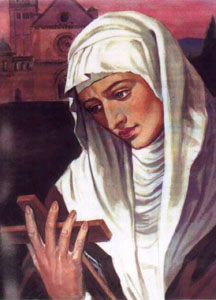Saint Agnes of Assisi
| Saint Agnes of Assisi | |
|---|---|
 |
|
| Abbess | |
| Born | 1197/1253 Assisi, Italy |
| Died | 16 November 1253 Assisi, Italy |
| Venerated in |
Roman Catholicism Order of St. Clare |
| Canonized | cultus confirmed 1753 by Pope Benedict XIV |
| Major shrine |
Basilica of St. Clare Assisi, Italy |
| Feast | 16 November |
| Attributes | Poor Clare nun holding a book |
Saint Agnes of Assisi, O.S.C., (1197/1198 – 16 November 1253) was the younger sister of Saint Clare of Assisi and one of the first abbesses of the Order of Poor Ladies.
She was a younger daughter of Count Favorino Scifi. Her birth name was probably Caterina; she took the name of Agnes when she became a nun. Her mother, Ortolana, who also would join the Order founded by her daughters, belonged to the noble family of the Fiumi. Their cousin Rufino was one of the original "Three Companions" of Francis of Assisi. Agnes' childhood was passed between her father's palace in the city and his castle of Sasso Rosso on Mount Subasio.
On 18 March 1212, her eldest sister Clare, inspired by the example of St. Francis of Assisi, left their father's home in secret to become a follower of the saint. Sixteen days later, Agnes ran off to the Benedictine Monastery of St. Angelo where St. Francis had brought her sister, resolved to share Clare's life of poverty and penance. Angry at having lost two of his daughters, their father sent his brother Monaldo, and several relations and armed followers to the monastery to force Agnes, if persuasion failed, to return home.
Monaldo drew his sword to strike his niece, but his arm allegedly dropped to his side, withered and useless. The others dragged Agnes out of the monastery by her hair, striking her and kicking her repeatedly. Agnes' body reportedly became so heavy, perhaps due to the help of her sister, that her assailants dropped her in a field nearby. Agnes' relatives, purportedly realizing that something divine protected her, allowed the sisters to remain together. Saint Francis himself cut her hair and gave her the religious habit, in recognition of Agnes' dedication.
Francis later established a cloister for Clare and Agnes at the rural chapel of San Damiano, where they were soon joined by other noble women of the city, and the Order of Poor Ladies, later known as the Poor Clares, began, with Clare as its abbess. In 1221 the Abbess Clare chose her sister to lead a community of Benedictine nuns in the village of Monticelli (now a part of the city of Florence) who wished to embrace the way of life of the Poor Ladies. She later went on to establish other communities of the Order, including those of Mantua, Venice, and Padua. Agnes was said to be very virtuous, and as abbess she ruled with a benevolent kindness, knowing how to make the practice of virtue appealing to her Sisters.
...
Wikipedia
